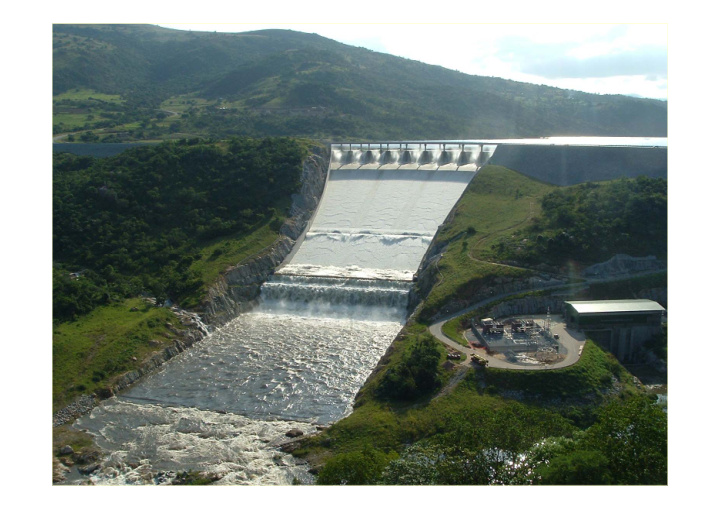



ANBO PRESENTATION KOPANONG HOTEL MARCH 2007 Progress with Cross Border IWRM in the IncoMaputo Basins Niel van Wyk Chief Engineer: National Water Resource Planning (East) Department of Water Affairs and Forestry, Republic of South Africa.
STRUCTURE OF PRESENTATION � Early history � Interim IncoMaputo Agreement � Subsequent activity
INCOMATI INCOMATI AND AND MAPUTO MAPUTO WATERCOURCES WATERCOURCES
EARLY HISTORY Phase 1 Before 1954: � Enough water for all needs � All countries develop with little or no consultation
EARLY HISTORY Phase 2 1954 to 1983 � All three countries develop considerable infrastructure with little or no consultation
EARLY HISTORY Phase 3 BILATERAL NEGOTIATION STARTS � 1980 – Competition for water forces Swaziland and RSA to enter into intensive consultation � Komati River Development Treaty between Swaziland and RSA signed in 1992 � Mozambique not directly involved
EARLY HISTORY Phase 4 TRILATERAL NEGOTIATION MATURES � 1991 - Piggs Peak Agreement start of meaningful trilateral interaction � Joint Incomati Basin Study results from Piggs Peak Agreement � Political situation in both Mozambique and RSA not conducive to interaction
INTERIM INCOMAPUTO AGREEMENT (IIMA) Phase 5 TRILATERAL COOPERATION 1998 – All three parties express the desire to develop a water use agreement
INSTITUTIONAL HIERARCHY � Heads of State � Water Ministers � Tripartite Permanent Technical Committee � Task Team
DEVELOPMENT OF AGREEMENT BROAD PROCESS: � Appoint Task Team � Terms of Reference � Development/negotiation process
RESULT TRIPARTITE INTERIM AGREEMENT BETWEEN THE REPUBLIC OF MOZAMBIQUE AND THE REPUBLIC OF SOUTH AFRICA AND THE KINGDOM OF SWAZILAND FOR CO-OPERATION ON THE PROTECTION AND SUSTAINABLE UTILISATION OF THE WATER RESOURCES OF THE INCOMATI AND MAPUTO WATERCOURSES
Signed at the World Summit on Sustainable Development in Johannesburg on 29 August 2002
Obligations � Manage water use � Pollution prevention � Information exchange � Communication � Capacity building
RESPONSIBILITIES OF THE PARTIES � Water quality management � Transboundary impact � Establishment of monitoring systems � Mitigation of the effects of floods and droughts � Partnership in effective and efficient water use � Security of infrastructure � Reference projects
OUTCOME � Commitment from member states � Basis for cross border cooperation � A milestone water agreement for southern Africa � Access to investor funding � National level planning with more certainty
LESSONS LEARNT � Develop tight tor � Begin with technical side – it allows for building of trust before political issues comes to the table � Secretarial function very important � Consider: transparency, honesty, integrity
LESSONS LEARNT (continued) � Process has to be supported from high managerial and political level (intervention sometimes required) � Participants should be capacitated beforehand � Process needs to be managed strongly � Negotiating rules unspecified
ELEMENTS/DRIVERS FOR SUCCESS � Political will � Common needs and objectives � Communication skills � Access to specialist knowledge � Strong management � Technical/subject knowledge � Administrative support � Trust � Patience � Understanding
FURTHER WORK Phase 6 � Convert into “CUSTOMARY INTERNATIONAL LAW” by parties taking action to interpret and apply the IIMA � Implementation of the IIMA
PROCESS � Analyse IIMA for work to be done � Develop implementation and activity plan � Develop Scopes of Work and ToR’s � Implement
WORK PACKAGES � WP1-Shared watercourse institutions � WP2-Review national water policies and legislation � WP3-Integrated water resource management � WP4-Augmentation of water supply to Maputo � WP5-Disaster management � WP6-Transboundary impacts
WORK PACKAGES (CONTINUED) � WP7-Exchange and access to information � WP8-Capacity and confidence building � WP9-Stakeholder participation � WP10-System operating rules � WP11-Preparation for comprehensive agreement � WP12-Managing the implementation of the IIMA
FIRST IMPLEMENTATION BATCH � TPTC strengthening � Project manager and coordinator � Information exchange � Maputo water supply study � Disaster management
POINT TO PONDER � On Orange-Senqu and Limpopo the strategy was to institute an RBO before a water use agreement � On the IncoMaputo the strategy was to do a water use agreement before an RBO � When reviewing the relative progress of the two approaches, are any conclusions to be reached?
CONTACT DETAILS N.J. (Niel) van Wyk Chief Engineer: National Water Resource Planning (East) Department of Water Affairs and Forestry, Private Bag X313 Pretoria 0001 Republic of South Africa. Landline (work) +27 123368327 Fax +27 123368295 Mobile +27 828085651 E-mail vanwykn@dwaf.gov.za
by Van Wyk Niel Photo Album
Recommend
More recommend